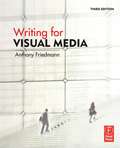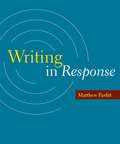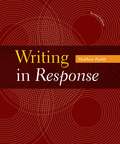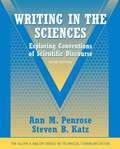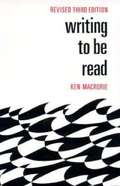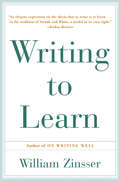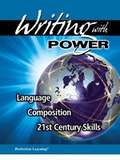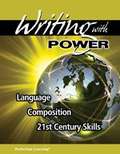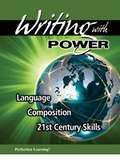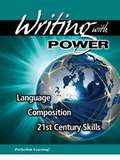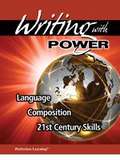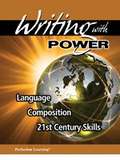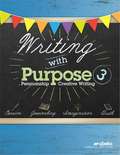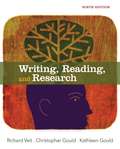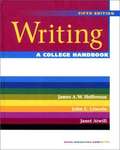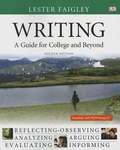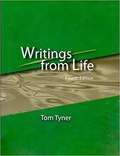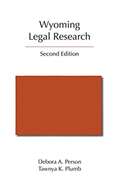- Table View
- List View
Writing for Success
by Scott McleanScott McLean's Writing for Success is a text that provides instruction in steps, builds writing, reading, and critical thinking, and combines comprehensive grammar review with an introduction to paragraph writing and composition. Beginning with the sentence and its essential elements, this book addresses each concept with clear, concise and effective examples that are immediately reinforced with exercises and opportunities to demonstrate, and reinforce, learning.
Writing for Visual Media (3rd Edition)
by Anthony FriedmannWriting for Visual Media looks at the fundamental problems a writer faces in learning to create content for media that is to be seen rather than read. It takes you from basic concepts to practice through a seven-step method that helps you identify a communications problem, think it through, and find a resolution before beginning to write. Through successive exercises, Writing for Visual Mediahelps you acquire the basic skills and confidence you need to write effective films, corporate and training videos, documentaries, web sites, PSAs, TV shows, nonlinear media, and other types of visual narratives. You'll explore your visual imagination and try out your powers of invention. The companion web site enriches the content of the printed book with video, audio, and sample scripts. It includes scripts and the video produced from them; visual demonstrations of concepts; and an interactive, illustrated glossary of terms and concepts.
Writing in Action (Level A)
by K12 Inc.Writing to a Prompt, Writing a Report, Writing Poetry, Writing from Personal Experience
Writing in Action (Level D)
by K12If you want to become a great writer then this is a very good book to refer to. It covers: writing to a prompt, writing a persuasive paper, writing news articles and writing a play.
Writing in Response
by Matthew ParfittWriting in Response is a flexible, brief rhetoric that offers a unique focus on the critical practices of experienced readers--analysis and reflection--the skills at the heart of academic writing. It helps students compose academic essays by showing how active reading and exploratory writing bring fresh ideas to light and how informal response is developed into polished, documented prose. Extensively class tested,Writing in Response emphasizes the key techniques common to reading, thinking, and writing throughout the humanities and social sciences by teaching students the value of a social, incremental, and recursive writing process.
Writing in Response (Second Edition)
by Matthew ParfittWriting in Response is a flexible, brief rhetoric that offers a unique focus on the critical practices of experienced readers, analysis and reflection, the skills at the heart of academic writing. It helps students compose academic essays by showing how active reading and exploratory writing bring fresh ideas to light and how informal response is developed into polished, documented prose. Extensively class tested, Writing in Response emphasizes the key techniques common to reading, thinking, and writing throughout the humanities and social sciences by teaching students the value of a social, incremental, and recursive writing process. The new edition includes more on working with digital tools, more help for writing, and updated readings.
Writing in Transit
by Denise K. ComerIdeal for both firstyear composition and interdisciplinary writing courses, Writing in Transit offers a twotiered approach to multidisciplinary writing. Author Denise Comer presents strategies and instruction for navigating the purposes for writing through riting transfer, which encourages students to reflect on what they learn in one context about writing, and about themselves as learners and writers, and then apply, extend, reject, or otherwise modify this knowledge for other disciplinary, interdisciplinary, and transdisciplinary contexts. Writing in Transit teaches students how to build practical bridges between disciplines’ discourse conventions by learning about the research and writing process.
Writing in the Sciences: Exploring Conventions of Scientific Discourse
by Ann M. Penrose Steven B. KatzA rhetorical, multi-disciplinary guide, Writing in the Sciences discusses the major genres of science writing including research reports, grant proposals, conference presentations, and a variety of forms of public communication. Multiple samples from real research cases illustrate a range of scientific disciplines and audiences for scientific research along with the corresponding differences in focus, arrangement, style, and other rhetorical dimensions. Comparisons among disciplines provide the opportunity for students to identify common conventions in science and investigate variation across fields.
Writing to Be Read (Revised Third Edition)
by Ken MacrorieThis book intends to give a thorough writing course to students that will help them express themselves efficiently.
Writing to Learn
by William ZinsserThis is an essential book for everyone who wants to write clearly about any subject and use writing as a means of learning.
Writing with Power: Language Composition 21st Century Skills [Grade 10]
by Joyce SennNIMAC-sourced textbook
Writing with Power: Language Composition 21st Century Skills [Grade 11]
by Joyce SennNIMAC-sourced textbook
Writing with Power: Language Composition 21st Century Skills [Grade 12]
by Joyce SennNIMAC-sourced textbook
Writing with Power: Language Composition 21st Century Skills [Grade 8]
by Joyce SennNIMAC-sourced textbook
Writing with Power: Language Composition 21st Century Skills [Grade 9]
by Joyce SennNIMAC-sourced textbook
Writing with Purpose 3
by Abeka BooksSharpen your 3rd graders’ penmanship skill and teach them to write with purpose. This book begins with various “Practical Penmanship” exercises to give students plenty of practice in the writing of words, letters, numbers –all in ¾” spacing lines! In 2nd semester, the focus will shift from using beautiful penmanship to learning to write compositions creatively. From beautiful penmanship to figurative language and poetry, your child will perfect his craft of writing in appearance and content. Teach him to observe the world around him, and then write about it. Different poem forms, alliteration, metaphors, and more are several English tools that your child will be able to recognize and use. Weekly penmanship test and supplementary writing exercises are also included in the back of the book.
Writing, Reading, and Research (9th Edition)
by Richard Veit Christopher Gould Kathleen GouldThis text is a composition course that prepares students for the tasks they will face during their college and professional careers developing skills in writing, reading and analyzing information.
Writing: A College Handbook (5th edition)
by James A. W. Hefferman John E. Lincoln Janet AtwillThe Fifth Edition exemplifies in clear, engaging prose the skills that students need to communicate in a wide variety of rhetorical contexts. A reliable and easy-to-use reference tool and an up-to-date rhetoric and research guide, Writing: A College Handbook invites students to discover the power of effective writing.
Writing: A Guide for College and Beyond, Fourth Edition
by Lester FaigleyFor college courses in Composition and Rhetoric. Revealing the writing process through interactive learning Writing: A Guide for College and Beyond presents writing, reading, and research processes dynamically, using a variety of visuals to illustrate how readers interact with texts and how writers compose. One of the first textbook authors to focus on multimedia composing, Lester Faigley employs his own advice to engage students in every step of the writing process-for both college composition and everyday life-and pulls back the curtain on how writers work. Aligned with the learning goals for a first-year college writing course identified in the 2014 Outcomes Statement from the Council of Writing Program Administrators, Writing: A Guide for College and Beyond gives students the support they need to succeed in first-year composition, in their other courses, and in their careers. In the Fourth Edition, students can also practice and explore what they've learned chapter-by-chapter with interactive MyWritingLab tools, assignments and projects. Also available with MyWritingLab(tm) This text is also available with MyWritingLab(tm) - an online homework, tutorial, and assessment program designed to work with this text to engage students and improve results. Within its structured environment, students practice what they learn, test their understanding, and pursue a personalized study plan that helps them better absorb course material and understand difficult concepts.
Writings From Life, Fourth Edition
by Tom TynerWritings from Life is a process-oriented writing textbook that helps students continue to grow and improve as writers. Students learn by writing, and the textbook provides a variety of writing assignments that require students to develop and apply different writing and thinking skills as they progress through the book.
Written All Over Your Face: Facial Recognition Technology (Fountas & Pinnell Classroom, Guided Reading)
by Susan StubbsNIMAC-sourced textbook
Wyoming Legal Research
by Debora A. Person Tawnya K. PlumbThe second edition of Wyoming Legal Research maintains the same practical research techniques and solid focus on Wyoming resources as the first edition. <p><p>The text, geared towards students and members of the general public with little to no experience in researching legal issues, is also appropriate for practicing attorneys wishing to identify the most effective coverage among specific legal resources. <p><p>This edition updates searching capabilities within the latest platforms of major commercial legal databases Lexis and Westlaw, with added coverage of newer products such as Bloomberg Law and Casemaker. The text includes information regarding access to freely-available primary and secondary legal resources on the internet as well as Wyoming-specific web sites and treatises. It explores the administrative process more deeply and updates Wyoming and federal legislative history features within both commercial and free databases. <p><p>The chapter on citating options, commonly known as Shepardizing, has been rewritten, as has the legal citation chapter which now references the revised editions of The Bluebook and ALWD Citation Manual. Images and examples have been updated throughout. Wyoming Legal Research remains an essential text for learning and practicing legal research in the state.
Y.O.U. (Your Own Universe)
by The Editors at the Scott ForesmanThis book is a collection of non-fiction, poems, stories and essays etc from different authors.

